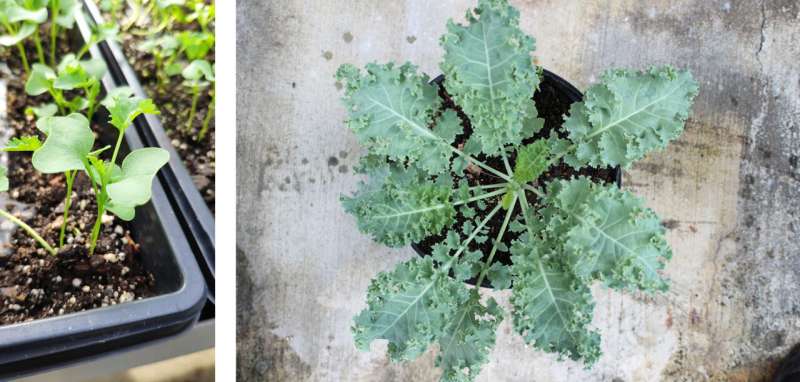This article has been reviewed according to Science X's editorial process and policies. Editors have highlighted the following attributes while ensuring the content's credibility:
fact-checked
trusted source
proofread
Microgreens and mature veggies differ in nutrients, but both might limit weight gain

Young vegetables known as microgreens are reputed to be particularly good for health. Now, researchers are trying to find out whether microgreens—which can easily be grown at home—are the superfood they're claimed to be, and how they compare to mature veggies. Results to date show their nutritional profiles differ, as do their effects on gut bacteria. Yet, tests in mice suggest that both microgreen and mature vegetables can limit weight gain.
The researchers will present their results today at the fall meeting of the American Chemical Society (ACS).
"The scientific literature suggests that cruciferous vegetables, like kale and broccoli, are good for you," notes Thomas T. Y. Wang, Ph.D., the project's principal investigator. The microgreen versions of these foods are particularly touted for their health benefits. Older than sprouts but younger than baby greens, microgreens are typically harvested within a couple of weeks after they start growing, and they can easily be grown in a container on a windowsill.
"When we started this research, not a lot was known about the nutrient content or biological effects of microgreens, so we thought we should take a look at them," says Wang, a scientist at the Agricultural Research Service of the U.S. Department of Agriculture (USDA). He is working with collaborators there and at the University of Maryland, College Park.
The team began their studies with another cruciferous plant—red cabbage. The researchers found that both young and fully grown cabbage limited weight gain in mice fed a high-fat diet. Yet the cabbage's nutrient profile changed over time, and the microgreen was significantly richer in substances such as glucosinolates—nitrogen- and sulfur-containing compounds that may offer protection from cancer, Wang says.
Next, the scientists turned their attention to kale. "We wondered whether the bioactive components in microgreen kale were different from those in mature kale," says Wang, "and we found that the nutritional composition is very different." For example, the immature plant has about five times more glucosinolates. Similarly, further studies by Wang's team and others have shown that nutrient levels in several other types of cruciferous vegetables are higher in the immature plants.
In their latest work, Wang and his colleagues are comparing the biological effects of microgreen and fully grown kale. They have discovered that both the young plant and mature kale are effective in limiting weight gain in mice fed a high-fat diet. Additional experiments will be needed to see if humans would experience these same benefits.
Wang believes the weight effects in mice may in part be related to the vegetable's impact on the animals' "microbiome," or the community of bacteria in the gut. Consumption of kale, regardless of its maturity, increases the variety of gut bacteria, the researchers have discovered. However, that enhancement is more pronounced with microgreens. That's important because greater bacterial diversity is generally associated with better health, Wang notes.
In future work, the team will continue to study the impact of other cruciferous plants on health. Those findings could help guide diners who dislike some of these foods but are seeking alternatives that taste better to them. "For instance, for people who don't like broccoli," Wang says, "can we find some other vegetable they like better that has similar health effects?"
It's also possible that the flavor profiles of these vegetables could be altered to make them more palatable. Some of the health-promoting constituents responsible for their characteristic flavor—such as glucosinolates—are bitter, but Wang speculates that these compounds might be present at higher levels than are necessary to reap health benefits. If that's the case, he says, these crops could potentially be bred to reduce those levels and the associated bitterness.
More information: Differential modulatory effects of kale microgreen and mature kale on the gut microbiome, ACS Fall 2023.




















